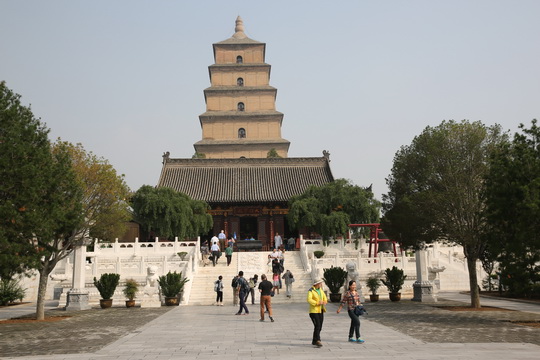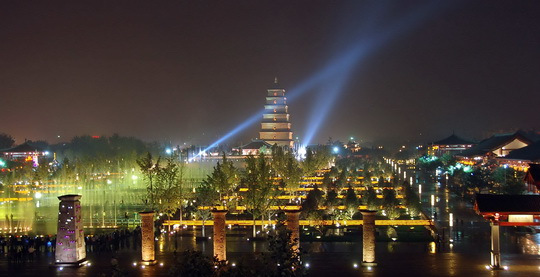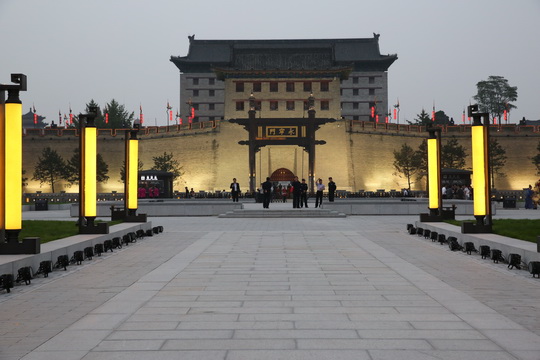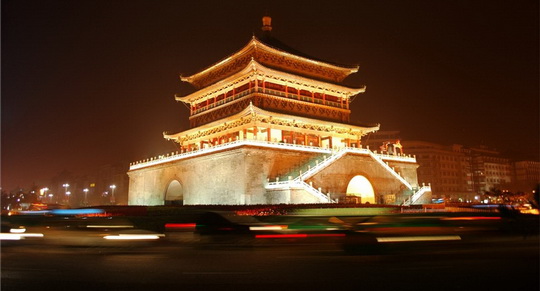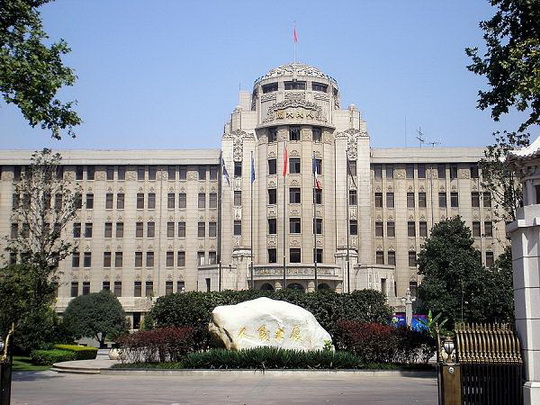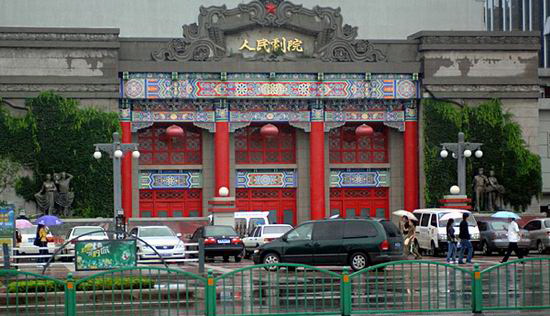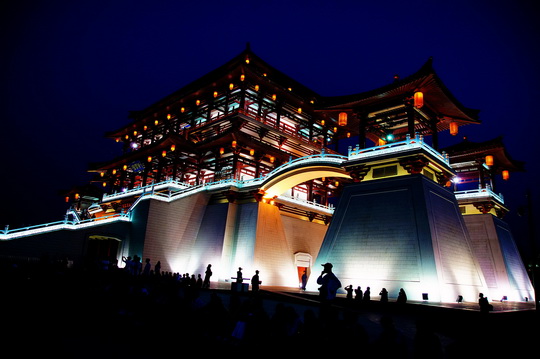A city’ name card or image symbol is best manifested in its iconic architectural landmarks. These landmarks are the barometer of the city’s history, economic development and the spiritual hope on it by its residents as well.
As one of the most famous ancient cities in China, Xian has its own unique cultural values and its historical sites.
To understand Xian’s landmarks is your first step to get to know Xian on your short Xian tour. Here are the seven you shouldn’t miss on your Xian tour.
1. Big Goose Pagoda (652) and its North Square (2003)
The Big Goose Pagoda is the most important symbol of the ancient city of Xian. It was originally built in 652 in Tang Dynasty ( 619 – 907 ) for Xuan Zang to put the scriptures and statues he had brought back from India.
It is the earliest and largest remaining brick square tower built in Tang Dynasty in China, an iconic Buddhist landmark combining the Indian Buddhist architectural forms with the Chinese Han vernacular building features. The present pagoda is 64.5 meters high with 7 stories, located inside Da Ci’en Temple south of Xian city centre.
Big Goose Pagoda
Musical Fountain at North Square of Big Goose Pagoda
Completed in 2003, the Big Goose Pagoda North Square mainly comprises Asia’s largest Tang Dynasty themed cultural plaza, Asia’ s largest musical fountain square, and Asia’s largest statue square. The construction of the huge cultural square features the Tang culture elements of Big Goose Pagoda and Da Ci’en Temple, combining the elements of the traditional and the modern. The music fountain starts at 8:00 pm everyday.
2. Xian Ancient City Wall ( 1274 – 1378 )
Xian Ancient City Wall is rectangle in shape with a perimeter of 14 km, 12 meters high, 18 meters wide at its base and 15 meters wide at its top. The wall has four main gates – East Changle Gate, West Anding Gate, South Yongning Gate and North Anyuan Gate.
The Xian city wall was built on the former imperial city walls of Tang Dynasty ( 619 – 907 ) and the current wall was rebuilt in 1374 and completed in 1378 with over 600 years.
South Gate to Xian City Wall
Xian City Wall was constructed in a way centered on a fairly complete defense system with its width longer than its height, standing as firm as a mountain. On the wall top, chariots and horses could be easily moved. It is the one of the most important city walls ever built in the late Middle Ages and the most well preserved ancient city wall in China.
After consistent repair and protection, the Xian City Wall now offers a good combination of the city wall, city moats and forest belt. You can walk, even cycle on the wall. Its south gate is the largest with a suspension bridge. Most of the tourists choose the south gate for sightseeing.
3. Xian Bell Tower (1384)
Xian Bell Tower was originally built in 1384 during Ming Dynasty ( 1368 – 1644 ). It is the largest and most well preserved bell tower among the numerous remaining bell towers in China. It is located in the heart of Xian city, the hub of the four avenues fanning out from the bell tower.
In ancient time, the bell in a bell tower was stricken at dawn and the drum in a drum tower was beat at sunset to indicate the end of the day.
The Xian Bell Tower was built on a square base, a wood and stone structure with two stories, three eaves and 4 upturned roof corners; it is 8.6 meters high at its base and 36 meters high above the base with a perimeter of 35.5 meters with an area of 1377.4 square meters. Today, the Bell Tower can only be accessed from the entrance on North Avenue. There is a staircase leading to the top of the Bell Tower.
4. Drum Tower (1380)
To the northwest of the Xian Bell Tower is the Xian Drum Tower. The Drum Tower is located in a busy street which is full of street traders and hawkers. The Drum Tower got its name from the huge drum located within the building. In ancient time, the bell in a bell tower was stricken at dawn and the drum in a drum tower was beat at sunset to indicate the end of the day.
The Drum Tower is 4 years older than Bell Tower and built in 1380 in Ming Dynasty ( 1368 – 1644 ). It went through two large-scale revamps in Qing Dynasty ( 1644 – 1911 ).
Today the Drum tower marks the southern entrance to the city’s Muslim Quarter which is an interesting area to walk around and have a look. You will feel as if you are in a “city within a city” in the Muslim Quarter. Atop the Drum Tower you will have a bird’s eye view of the Muslim Quarters.
5. Xian People’s Hotel (1953)
My selection of Xian People’s Hotel on the top list is to some extent due to the emotion and nostalgia the local Xian people have over the building. It used to the best hotel in 1950s where the experts from former Soviet Union stayed with a kind of mystery looming in people’s hearts.
The hotel was built in 1953 and revamped in 1985. It is one of the famous large courtyard hotels in China with an construction area of 63800 square meters. The hotel is composed of a group of buildings which feature the combination of Chinese architecture’s simplicity and elegance with the Western delicacy and splendor.
It is scattered with Chinese pavilion-topped buildings surrounded by classical Chinese gardens in a spacious compound. Today, part of the hotel complex has been turned to Sofitel Xian.
6. Xian People’s Theatre ( 1954 )
Xian People’s Theatre was originally built in 1954 in order to house the Northwest Art Work Troupe ( Today’s Shaanxi Singing and Dancing Troupe) that had been relocated from Yan’an to Xian.
The building features the mixed Chinese and Western architectural styles, and later it was encluded together with other 36 buildings completed in mainly in Beijing 1950s in the book named ” World Architecture History” published in UK.
Xian People’s Theater is known as the first modern theater in northwest China, hold more than 1000 persons. It is the venue for plenty of dramatic performances. Today, the theater is also converted into a dinner theater with integrated dining and entertainment. Add: No. 41, Beida Jie, Xincheng District, Xi’an.
7. Tang Paradise (2005)
Completed in 2005, Tang Paradise (大唐芙蓉园) is the largest culture theme park in the Northwest Region of China. Built and expanded on the former site of Tang Paradise in Tang Dynasty ( 618-907), now it is a model imperial garden to fully demonstrate the Tang Dynasty’s charm and grandeur.
The setting, a landscaped 165-acre site surrounding a willow-lined lake, captures something of the look and feel of classical Chinese landscape painting.
Throughout the Tang Paradise, there are twelve scenic regions including the attraction of Ziyun Tower Block, Elegant Lady Area, Imperial Banquet Hall, Fanglin Fragrant Garden, Phoenix Theater, Apricot Garden, Lu Yu Teahouse, Tang Marketplace and the Floating-drink at Qujiang Lake.
The Water Film is the main attraction in Tang Paradise. The screen of the water is a film of water, which makes you a wonderful and illusory feeling that you were on the scene in person. When the figures in the movie appear on the screen, it seems that they are flying to the sky or coming down from the heaven. It is indeed a splendid ocular enjoyment.
Open Time: 9:00 am-21:00 pm
Entrance fee: RMB 120 (high season): RMB90 (Low season)
Add: 99 Furong West Road, Qujiang New District, Xian ( to the southeast of Big Goose Pagoda)
How to there
Take Bus 609 from Bell Tower area and get off at the 12th stop of Tang Paradise (大唐芙蓉园)
Tip: Hassle-free Xian Guided Tours
If you don’t want to go the do-it-yourself route and prefer the hassle-free escorted tours, here are some options for Xian guided tours:
Xian Tour
Xian Day Tour
Xian Tour Packages
Beijing Xian Tour
Further Readings
Beijing Xian High Speed Train Experience
Best Time to Visit Xian
How to Visit Xian in Two Days?
Xian Airport Transportation
Xian Railway Station Transportation
Xian Taxi: Xian Taxi Fares, Tips and Phones
Xian City Layout
Xian’s Top 7 Iconic Landmarks
Where to Stay in Xian
Top 10 Attractions in Xian
Top Things to Do for Kids in Xian
How Visit Terracotta Army
How to Visit Xian on a Budget
The Starbucks in Xian
Top Markets in Xian
Top 10 Shopping Malls in Xian
Top 10 Best Restaurants in Xian
Top 10 Souvenirs in Xian
Xian Tourist Traps, Xian Tourist Scams
Tips for Visiting Muslim Quarter in Xian
Tips for Visiting Xian City Wall
The Ramparts of Quebec City and Xian City
Tips for Visiting Shaanxi History Museum
Tips for Visiting Xian Bell Tower
How to Visit Daming Palace National Heritage Park
Top 10 Photography Spots in Xian
The Night View of Great Tang All Day Mall
Tips for Visiting Hanyang Tombs Xian
The Song of Everlasting Sorrow Show in Xian
Tips for Visiting Big Wild Goose Pagoda
Yaodong Cave Dwellings in Xian
Tips for Visiting Huaqing Hot Springs in Xian
How to Visit Mount Huashan
Mt.Huashan Snow Scenes Photos
How to visit Xiyue Temple
Top 10 Hostels in Xian
Top 10 Xian Luxury & Boutique Hotels
Xi’an: An Exotic City with an Undeniable Historical Depth
Best Places to See Autumn Leaves around Xian
Muslim Streets in Muslim Quarter in Xian
Hua Jue Xiang, Huajue Lane at Xian Muslim Quarter
The Night View of Great Tang All Day Mall
Xian City Wall Night View
What to do in Xian after dark
Xian’s Best Street Food
Xian Muslim Quarter Exotic Food
Xian Bar Street
Spring Festival Lantern Exhibit in Xian
Xian Terracotta Army Pictures
How to Visit Maijishan Grottoes from Xian by Train
How to Visit Hukou Waterfall
How to Visit Huangdi Mausoleum
Xian Lhasa Flight Experience (Tips, Photos & Map)
Beijing Xian Flight Experience
Datong Xian High Speed Train
Reviews on Beijing Xian Luoyang Tour
Visit Xian in January (Weather, Wear, & Tips)
Visit Xian in February
How to Visit Xian in March
Visit Xian in October
How to Visit Xian in November
Visit Xian in December
Any questions, just drop a line.






